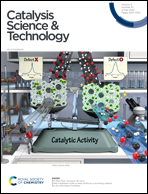(In situ) spectroscopic studies on state-of-the-art Pd(ii) catalysts in solution for the alkoxycarbonylation of alkenes†
Abstract
Compositions of homogeneous Pd complexes bearing pyridyl-substituted diphosphines for the alkoxycarbonylation of alkenes have been studied in detail and characterized by (in situ) NMR and IR spectroscopy. The detectable resting state complexes in solution are of the type [(P∩PN)PdII(O3SR)](O3SR). Results from X-ray crystallography and NMR spectroscopy confirm the crucial coordination of a nitrogen atom to the Pd(II) centre. In situ catalyst formation starting from different Pd precursors at higher concentrations leads to mixtures containing the same type of resting state complex, but with different amounts. Under catalytic conditions, slight differences in the catalytic activities were observed with selected pre-catalysts. Thus, the exact reaction conditions obviously have an influence on the process of catalyst formation and on the catalytic performance. At higher Pd concentrations in the presence of ethene and carbon monoxide, also the corresponding sulfonato complexes represent the dominant detectable species.



 Please wait while we load your content...
Please wait while we load your content...